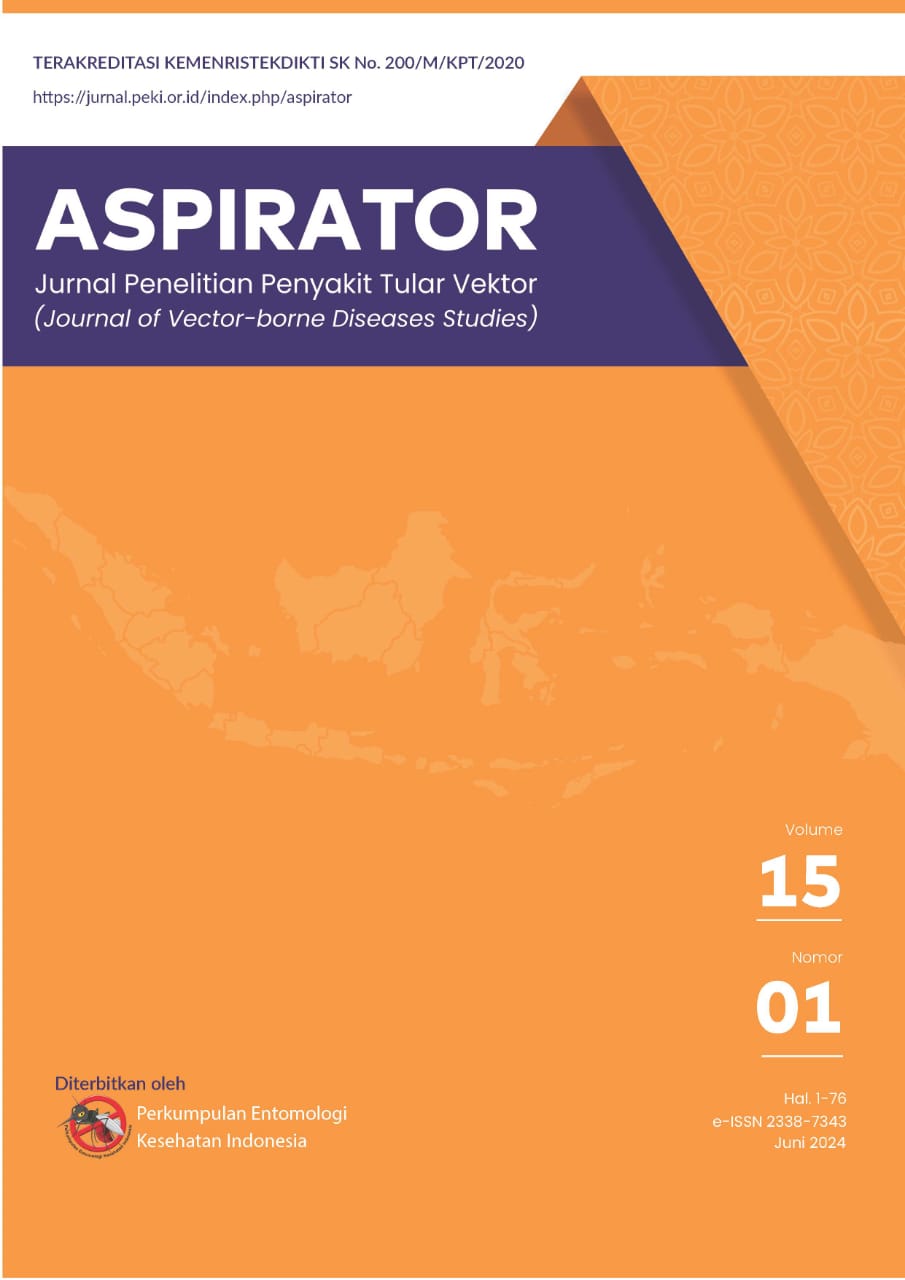Potensi Nyamuk Sebagai Vektor Di Daerah Endemik Filariasis Kabupaten Bogor, Jawa Barat
Potential of Mosquito as Vectors In Filariasis Endemic Area, Bogor District, West Java
DOI:
https://doi.org/10.58623/aspirator.v15i1.76Keywords:
Bogor, detection, filariasis, mosquito, vectorAbstract
Mosquitoe vectors of filariasis must have a long life so that the parasite can complete its life cycle in the mosquito’s body. Mosquitoes with high parity are generally more at risk of transmitting pathogens, as they have made more bites on hosts that have the potential to carry the infection. This study aims to detect the potential of mosquito vectors by calculating the parity number and examining the causative agent in the mosquito’s body. Mosquito parity examination was based on the results of mosquito ovary dissecting during a capture period. Detection of the causative agent was carried out by dissecting tecnique and polymerase chain reaction (PCR). The results showed that the parity rate of mosquitoes caught in Tamansari Village and Cimanggis Village was very high (>80%). Detection
of the causative agent using surgical and PCR methods did not find any L3 larvae and microfilariae in the examined mosquitoes.
References
WHO. Integrating neglected tropical diseases into global health and development: Fourth WHO report on neglected tropical diseases. WorldHealth Organization: Geneva.2017.
Bockarie MJ, Pedersen EM, White GB, Michael E. Role of vector control in the global program to eliminate lymphatic filariasis. Annu Rev Entomol. 2009; 54: 469–487. DOI: https://doi.org/10.1146/annurev.ento.54.110807.090626
da Rocha EMM, Fontes G, Ehrenberg JP. Lymphatic filariasis. Springer.2017. pp:369–381. DOI: https://doi.org/10.1007/978-3-319-13884-8_24
Masrizal. Pernyakit filariasis. J Kesehat Masy. 2013; 7: 32–38. DOI: https://doi.org/10.24893/jkma.v7i1.105
Arsin AA. Epidemiologi filariasis di Indonesia. Masagena Press Makassar: Makassar.2016.
Fischer P, Wibowo H, Pischke S, Rückert P, Liebau E, Ismid IS et al. PCR-based detection and identification of the filarial parasite Brugia timori from Alor Island, Indonesia. Ann Trop Med Parasitol. 2002; 96: 809–821. DOI: https://doi.org/10.1179/000349802125002239
Willa RW. Situasi filariasis. Media Litbang Kesehat. 2011; 22: 45–50.
Santoso, Yahya, Suryaningtyas NH, Rahayu KS. Deteksi mikrofilaria Brugia malayi pada nyamuk Mansonia spp dengan pembedahan dan metode PCR di Kabupaten Tanjung Jabung Timur. ASPIRATOR - J Vector-borne Dis Stud. 2015; 7: 29–35. DOI: https://doi.org/10.22435/aspirator.v7i1.3728.29-35
Santoso, Ambarita L, Oktarina R, Sudomo M. Epidemiology filariasis in Sungai Rengit village, district Talang Kelapa, Banyuasin regency 2006. Bul Penelit Sist Kesehat. 2008; 36: 59–70.
Ramadhani T, Wahyudi BF. Keanekaragaman dan dominasi nyamuk di daerah endemis filariasis limfatik, Kota Pekalongan. J Vektor Penyakit. 2015; 9. doi:10.22435/vektorp.v9i1.5037.1-8. DOI: https://doi.org/10.22435/vektorp.v9i1.5037.1-8
Febrianto B, I.P AM, Widiarti. Faktor risiko filariasis di Desa Samborejo, Kecamatan Tirto, Kabupaten Pekalongan Jawa Tengah. Bull Penelit Kesehat. 2008; 36: 48–58.
Depkes. Ekologi vektor dan beberapa aspek perilaku. Ditjen PPM & PLP: Jakarta.2002.
WHO. Manual on practical entomology in malaria II : Methods and techniques. World Health Organization: Geneva.1975.
WHO. Lymphatic filariasis (A Handbook For National Elimination Programmes). World Health Organization: Geneva.2013.
Qiagen. QIAamp DNA mini and blood mini handbook. Qiagen. 2016; : 1–72.
Ridha MR, Sembiring WRG. Perilaku mengisap darah dan perkiraan umur populasi di alam nyamuk potensial vektor filariasis di Desa Dadahup, Kabupaten Kapuas, Kalimantan Tengah. J Vektor Penyakit. 2019; 13: 77–86. DOI: https://doi.org/10.22435/vektorp.v13i2.1008
Ramadhani T. Komposisi spesies dan dominasi nyamuk Culex di daerah endemis filariasis limfatik di Kelurahan Pabean Kota Pekalongan. Balaba J Litbang Pengendali Penyakit Bersumber Binatang Banjarnegara. 2009; 5: 7–11.
Widyastuti U, Boewono DT, Widiarti, Supargiyono, Satoto TBT. Kompetensi vektorial Anopheles maculatus , Theobald di Kecamatan Kokap, Kabupaten Kulonprogo. Media Litbang Kesehat. 2013; Vol 23 No: 47–57.
Portunasari WD, Kusmintarsih ES, Riwidiharso E. Survei nyamuk Culex spp. sebagai vektor filariasis di Desa Cisayong, Kecamatan Cisayong, Kabupaten Tasikmalaya. Biosfera. 2017; 33: 142. DOI: https://doi.org/10.20884/1.mib.2016.33.3.361
Haryuningtyas D, Subekti DT. Deteksi mikrofilaria / larva cacing Brugia malayi pada nyamuk dengan polimerace chain reaction. Jitv. 2008; 13: 240–248.
Nurjana MA, Anastasia H, Widjaja J, Srikandia Y, Widayati AN, Murni et al. Program pengendalian filariasis di Kabupaten Donggala , Sulawesi Tengah. J Vektor Penyakit. 2020; 14: 103–112. DOI: https://doi.org/10.22435/vektorp.v14i2.2512
Yahya, Salim M, Arisanti M. Deteksi Brugia malayi pada Armigeres subalbatus dan Culex quinquefasciatus yang diinfeksikan darah penderita filariasis dengan metode PCR. ASPIRATOR - J Vector-borne Dis Stud. 2014; 6: 35–42. DOI: https://doi.org/10.22435/aspirator.v6i2.3623.35-42
Fischer P, Boakye D, Hamburger J. Polymerase chain reaction-based detection of lymphatic filariasis. Med Microbiol Immunol. 2003; 192: 3–7. DOI: https://doi.org/10.1007/s00430-002-0152-z
Plichart C, Sechan Y, Davies N, Legrand AM. PCR and dissection as tools to monitor filarial infection of Aedes polynesiensis mosquitoes in French Polynesia. Filaria J.2006; 5: 1–9. DOI: https://doi.org/10.1186/1475-2883-5-2
Nasution SF, Adhiyanto C, Indahwati E. Preliminary study of Wuchereria bancrofti L3 larvae detection in Culex quinquefasciatus as vector potential of filariasis in endemic area of South Tangerang, by utilizing PCR assay for L3-activated cutilin transcrip mRNA gene and TPH-1 gene. Indones J Trop Infect Dis. 2018; 7: 67. DOI: https://doi.org/10.20473/ijtid.v7i3.7352
Downloads
Published
How to Cite
Issue
Section
License
Copyright (c) 2024 Muhammad Nirwan

This work is licensed under a Creative Commons Attribution-ShareAlike 4.0 International License.
Authors retain copyright and grant the journal right of first publication with the work simultaneously licensed under a Creative Commons Attribution (CC-BY) 4.0 License that allows others to share the work with an acknowledgment of the work’s authorship and initial publication in this journal.






